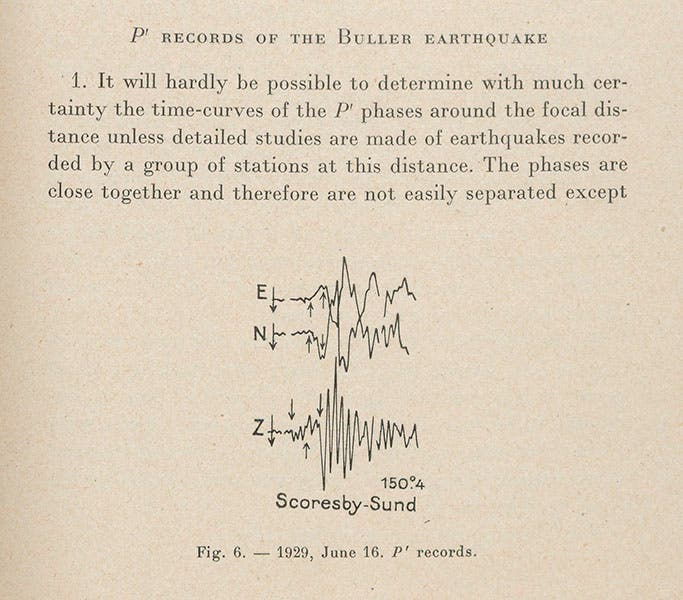Scientist of the Day - Inge Lehmann
Inge Lehmann, a Danish seismologist, was born May 13, 1888. In the early 1930s, Lehmann was studying seismic waves that were being reflected from various layers within the earth, and she observed that there were certain reflections that could not be explained by the known internal structure of the earth. At that time, it was understood that the earth has a core, probably molten, about 4000 miles across, which produced some of the reflections, but not much more was known beyond that. In 1936, Lehmann proposed that there must be a solid inner core that lies inside the molten outer core, with the outer boundary of the inner core being the source of the anomalous echoes.
In a modern diagram of a cross-section of the earth (second image), one can see various reflections and refractions of P-waves (pressure waves) that have been drawn in. For example, waves labelled P travel entirely through the mantle, while PKP is a wave that travels through the mantle, the outer core, and the mantle again. The reflection Lehmann was trying to account for is the one labeled PKiKP, and the small circle it is reflecting from is the postulated inner core. Lehmann turned out to be quite right – the earth does have an inner core about the size of Pluto, and the inner core plays an important role in modern geophysics in explaining such matters as the magnetic field of the earth (and the PKiKP reflection).
Lehmann made her discovery at a time when there were hardly any women working in seismology, and initially she got little credit or professional respect, even in her home country. But she retired in 1953, which freed her from the duties of running a seismological station in Copenhagen, and she spent the rest of her life moving around the globe pursuing seismic events, and visiting such important institutions as the Lamont Doherty Geophysics Laboratory in New York and the Seismology Lab at Cal Tech in Pasadena, where she met such preeminent American seismologists as Maurice Ewing and Beno Gutenberg.
Her standing in the community gradually rose, as geologists realized how sharp this woman was and how much she knew about seismology. Since she lived for 50 years after retiring (to the age of 104!), there was plenty of time for her reputation to grow. A International Symposium was held in 1986, to mark the 50th anniversary of the discovery of the inner core, and even though Lehman was 48 years old when she made her discovery, she was still able to be the featured guest at the symposium, 50 years later. That does not happen very often. Since 1997, the International Geophysical Union has given an award, the Inge Lehmann medal, for achievements in understanding the deep structure of the earth. It is an attractive medal, with Lehman’s portrait on the front.
Lehmann’s paper of 1936 is interesting for another reason; its title is the shortest title of any milestone paper in the history of science (fifth image). Lehmann titled it “ P’ “, pronounced “P prime”, where “P” stands for P-wave and “prime” indicates the anomalous reflection. The paper appeared in the Publications du Bureau Central Séismologique International for 1936, and we have that volume in the Library’s serials collection. We show here two diagrams from that paper (third and fourth images).
In 2017, a sculpture honoring Lehmann was installed in front of entrance to the University of Copenhagen. We chose not to illustrate it here, but you may see in at this website. On the opposite side of the entrance is a more conventional bust of the great Danish physicist, Niels Bohr.
Dr. William B. Ashworth, Jr., Consultant for the History of Science, Linda Hall Library and Associate Professor, Department of History, University of Missouri-Kansas City. Comments or corrections are welcome; please direct to ashworthw@umkc.edu.










